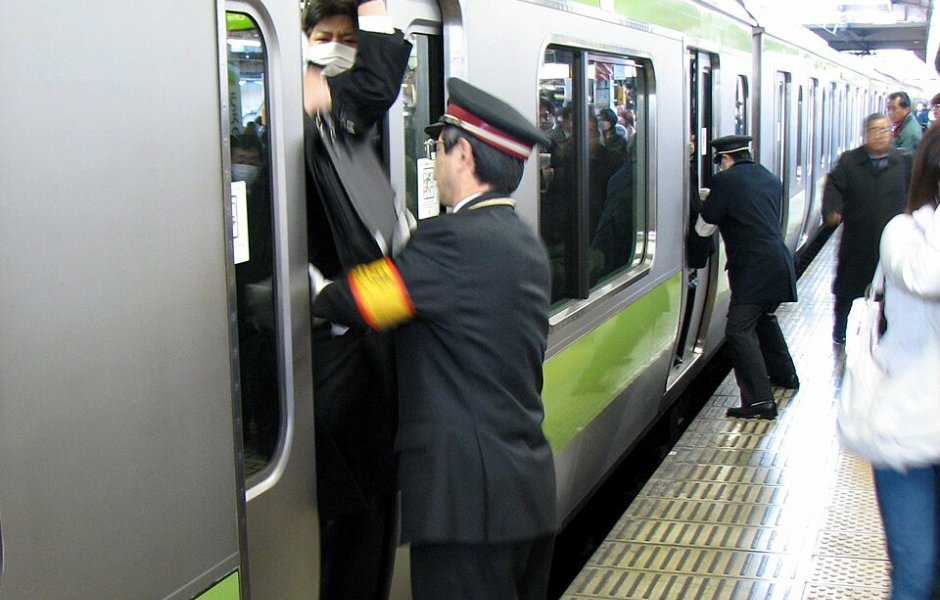
This children’s article, Unusual Jobs: Meet the Oshiyas, Japan’s train pushers, has been written for native English speakers and learners of English as a second or foreign language. It helps children practise reading and comprehension, learn exciting vocabulary, and discover one of the world’s strangest jobs. Written by Mark Pulley, a writer and EFL teacher since 2017, who creates fun and informative news articles for English learners.
Main image licence – https://commons.wikimedia.org/wiki/File:Rush_hour_at_Ueno_02.JPG
What is an Oshiya?
Imagine trying to squeeze onto a train so packed you can barely move. In Tokyo, Japan, this happens every day! That’s why there are special people called Oshiyas, or “pushers”, who literally push passengers onto crowded trains so the doors can close.
Oshiyas wear uniforms, gloves, and hats, and stand on the train platforms during rush hour. Their job might sound silly, but it helps thousands of people get to work or school on time. Trains in Tokyo are known for being incredibly fast and always on schedule, thanks in part to the Oshiyas!
Why are trains so busy in Japan?
Japan’s cities are very crowded places. Tokyo is the most populated city in the world, with over 37 million people (that’s 10 million more than the whole of Australia!), and many of them use public transport instead of cars.
Underground trains are by far the quickest way to travel through the city. So it’s no surprise that during rush hour, millions of people are on the move, and platforms become super crowded.
To make sure everyone gets where they’re going, train stations bring in the Oshiyas. They make sure people are packed safely inside before the doors close.
Is it safe?
Even though it looks chaotic, Japanese trains are well-designed and very safe. Oshiyas are trained to push in a way that doesn’t hurt anyone. And don’t worry, they only push gently and stop as soon as the doors close.
While some visitors find it a bit shocking, most locals are used to it and even thankful for the help.
Is it still a job today?
Oshiyas were common all over Japan in the 1960s and 1970s, a time when train stations were even busier than today. These days, better train designs and smarter systems mean fewer pushers are needed, but they still appear during the busiest times in Tokyo.
It might seem like a weird job, but being an Oshiya helps keep the world’s most populated city moving!
If you want to see an Oshiya in action, you can watch this YouTube video.

Article vocabulary list
- Oshiya – A person whose job is to push people onto crowded trains.
- Platform – The area next to a train where people stand before getting on.
- Rush hour – The busy time of day when lots of people travel to or from work or school.
- Uniform – Special clothes worn by people doing certain jobs.
- Schedule – A plan that shows when something happens, like a train timetable.
- Public transport – Buses, trains, and other vehicles that everyone can use.
- Chaotic – Very busy and disorganised.
- Gently – In a soft and careful way.
Comprehension questions
Just click the plus (+) to see the answer
1. What does an Oshiya do?
a) Fixes train tracks
b) Pushes people onto trains
c) Drives the train
Answer: b) Pushes people onto trains
2. Why are Oshiyas needed in Japan?
a) Because the trains are too slow
b) Because people don’t like walking
c) Because the trains get very full
Answer: c) Because the trains get very full
3. When are Oshiyas usually seen?
a) At lunchtime
b) During rush hour
c) At night
Answer: b) During rush hour
4. Is being pushed onto a train dangerous in Japan?
a) No, it is done gently and safely
b) Yes, it is very risky
c) Only for tourists
Answer: a) No, it is done gently and safely
5. Are Oshiyas still common today?
a) Not really, but some still work during busy times
b) Yes, every station has lots of them
c) No, the job no longer exists
Answer: a) Not really, but some still work during busy times

Mark is a writer and EFL teacher from England with eight years’ experience. He’s passionate about travel, sport (especially football), animals, nature, and history, and enjoys helping children explore the world through language and learning.




